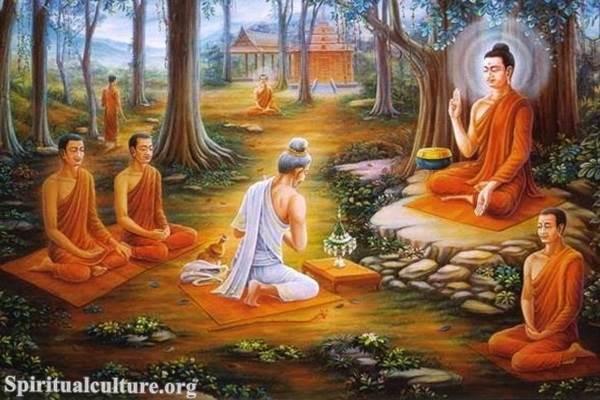Silence is often perceived simply as the absence of sound, yet in Buddhism, it embodies far more profound dimensions. It is the fertile ground from which mindfulness, insight, and spiritual awakening spring forth. In the silent pauses of our lives, we encounter our deepest selves, becoming attuned to truths often obscured by noise and distraction.
At Spiritual Culture, we invite you to explore the sacred role silence plays in Buddhist practice. Why is silence essential? How does it transform our spiritual lives, and how can integrating silence into daily practice lead to profound inner clarity and enlightenment? Journey with us into this gentle quiet, and uncover the spiritual riches it holds.
The Sacredness of Silence in Buddhism
In Buddhist teachings, silence is revered as an essential spiritual tool, a pathway that leads directly to deeper mindfulness and clarity of insight. Buddhism views silence not merely as the absence of speech or noise but as an active, intentional state, a fertile space wherein spiritual awakening is cultivated. Through silence, we engage directly with the present moment, reducing distractions and enabling our innate wisdom to emerge naturally.
Historical Perspectives on Silence in Buddhism
The Buddha himself exemplified the profound use of silence in his teachings. On several occasions, his silence was the teaching itself—expressing truths beyond words. One renowned example is the Flower Sermon, where the Buddha simply held up a flower without speaking. Among all present, only his disciple Mahākāśyapa understood, responding with a silent smile. This powerful transmission, occurring entirely without words, symbolizes silence as the purest expression of spiritual truth, transcending intellectual analysis.
Silence in Buddhist Monastic Life
Monastic communities in Theravada, Mahayana, and Zen Buddhism strongly emphasize silence as central to spiritual practice. Silence permeates their daily routines, including meals, meditation, and retreats, cultivating an environment conducive to mindfulness and introspection. In Theravada monasteries, noble silence—a deliberate choice to abstain from unnecessary speech—is practiced to preserve the meditative atmosphere. Similarly, Zen monasteries practice periods of strict silence during sesshin (intensive meditation retreats), facilitating deep concentration and insight.
The Transformative Power of Silence
Silence has the unique capacity to transform consciousness. By quieting the incessant chatter of the mind, silence provides a refuge where practitioners can develop mindfulness, gain clarity, and experience direct insight into the nature of reality.
Cultivating Mindfulness Through Silence
The practice of mindfulness, central to all Buddhist traditions, thrives in silence. Mindfulness meditation often begins by focusing on the breath or bodily sensations in a quiet environment. Silence supports sustained attention, making it easier to observe the mind’s subtle movements. As awareness deepens, practitioners begin to see the impermanence of their thoughts, emotions, and sensations—fundamental realizations in Buddhist teachings.
The Satipatthana Sutta, a foundational text on mindfulness, encourages silence as the context within which deep contemplation unfolds:
“Here, monks, a monk, having gone to the forest, or to the root of a tree, or to an empty hut, sits down cross-legged, holds his body erect, and establishes mindfulness in front of him.”
(Majjhima Nikaya 10)
This silence is not mere emptiness but a vibrant space in which mindfulness grows naturally, revealing deeper truths about self and existence.
Silence as the Gateway to Insight
In Buddhism, silence is the essential precursor to insight (vipassana). By reducing external noise and internal mental chatter, silence helps practitioners penetrate deeply into the nature of reality, unveiling the truths of impermanence (anicca), suffering (dukkha), and non-self (anatta). The Buddha taught that only a quiet mind can observe clearly and perceive reality without distortion.
Zen Master Thích Nhất Hạnh succinctly states:
“Silence is essential. We need silence just as much as we need air, just as much as plants need light. If our minds are crowded with words and thoughts, there is no space for us.”
In silence, there emerges space to directly experience life as it truly is, free from the biases and habitual patterns of thinking.
Integrating Silence into Everyday Life
While monastics practice silence intensively, lay practitioners can also benefit significantly by integrating silent moments into their daily routines. Silence becomes a practical tool for spiritual growth accessible to everyone, regardless of their lifestyle or environment.
Simple Practices for Daily Silence
- Morning Silence: Begin each day with 10–15 minutes of silent meditation, setting an intention of mindful awareness for the day.
- Silent Meals: Occasionally eat a meal in complete silence, observing the sensations of taste, smell, and texture, fully savoring the nourishment provided.
- Mindful Walks: Take walks without headphones or conversation, fully immersing yourself in the sensory experience of nature or urban surroundings.
- Evening Reflection: Dedicate a quiet time before bed to reflect silently on your day, fostering gratitude, insight, and peace.
Silent Retreats: Deepening the Practice
Silent retreats, such as Vipassana courses and Zen sesshin, offer structured opportunities for deeper immersion in silence. These retreats, ranging from days to weeks, allow participants to experience the transformative effects of prolonged silence. Without the usual distractions, practitioners discover profound depths of awareness, clarity, and emotional release, facilitating significant spiritual breakthroughs.
Silence and Inner Healing
Beyond spiritual insight, silence in Buddhism holds profound healing potential. By turning inward and embracing silence, individuals can confront and heal emotional wounds, anxieties, and mental turmoil.
Emotional Clarity Through Silence
In silence, emotional noise is quieted, allowing practitioners to directly encounter and process suppressed emotions. This confrontation, while initially challenging, is ultimately therapeutic, leading to greater emotional balance and well-being. Silence, therefore, becomes a gentle yet powerful healer, enabling the integration and release of past traumas and present anxieties.
The Tibetan Buddhist master Dilgo Khyentse Rinpoche explains this healing process vividly:
“Rest in natural great peace, this exhausted mind, beaten helplessly by karma and neurotic thoughts, like the relentless fury of the pounding waves in the infinite ocean of samsara.”
By resting in silence, practitioners can find peace within their mental and emotional turbulence, revealing an intrinsic clarity and calmness beneath the surface chaos.
Silence as Communion and Connection
Though silence seems solitary, in Buddhist practice, it often deepens our connection with others and the world around us. Silence becomes a universal language of compassion, understanding, and communal support.
Shared Silence as Spiritual Fellowship
Group meditation in silence cultivates a powerful sense of shared experience and spiritual fellowship. Even without words, practitioners find profound interconnectedness, solidarity, and collective wisdom. This communal silence strengthens relationships based on empathy and compassion rather than mere verbal communication.
Reflect and Reimagine
Silence is far more than a passive state—it is a sacred tool, transformative practice, and profound healer in Buddhist spirituality. Whether through brief daily practices or intensive silent retreats, embracing silence can radically reshape your spiritual journey, offering clarity, insight, and deep inner peace.
We invite you to integrate mindful silence into your own life, discovering firsthand how this quiet practice can lead you gently toward enlightenment and compassionate living. Take a moment, right now, to pause in silence. Feel its depth, embrace its simplicity, and experience the truth it quietly reveals.
May you find peace and awakening in the sacredness of silence.


